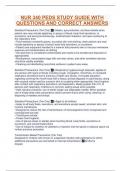NUR 340 PEDS STUDY GUIDE WITH
QUESTIONS AND CORRECT ANSWERS
Standard Precautions (Tier One) ✅• Masks, eye protection, and face shields when
patient care may include splashing or sprays of blood, body fluid secretions, or
excretions, and during bronchoscopy, endotracheal intubation, and open suctioning of
the respiratory tract
• Fluid-resistant nonsterile gowns, to protect skin and clothing, when patient care may
include splashing or sprays of blood, body fluid secretions, or excretions
• Patient care equipment handled in a manner that prevents skin or mucous membrane
exposure and contamination of clothing
• All used linen is considered contaminated and needs to be handled and disposed of
appropriately.
• Mouthpieces, resuscitation bags with one-way valves, and other ventilation devices
should be readily available.
• Cleaning and disinfecting noncritical surfaces in patient care areas
Standard Precautions (Tier One) ✅• Respiratory hygiene/cough etiquette: applies to
any person with signs of illness including cough, congestion, rhinorrhea, or increased
respiratory secretions that is entering a health care facility. It includes education
regarding covering the mouth/nose with a tissue; prompt disposal of used tissues, along
with surgical masks used by a person who is coughing when appropriate; hand hygiene
after contact with respiratory secretions; and separation, ideally greater than 3 ft, of
persons with respiratory infections in common waiting areas when possible
• Safe injection practices: use of sterile single-use disposable needle. When possible
use of single-dose vials; precautions used to prevent injury when using, cleaning, or
disposing of needles and sharps
Standard Precautions (Tier One) ✅• Apply to all children
• Apply to all body fluids, secretions, and excretions except sweat, nonintact skin, and
mucous membranes
• Designed to reduce the risk of transmission of microorganisms from recognized and
unrecognized sources
• Techniques include:
• Proper hand hygiene.
• Use of gloves (clean or sterile) when touching blood, body fluids, secretions or
excretions, and contaminated items
• Use of masks for insertion of catheters or injection into the spinal or epidural space via
lumbar puncture procedure
Transmission-Based Precautions (Tier Two)
Designed for children with known or suspected infection with pathogens for which
additional precautions are warranted to interrupt transmission ✅Air-Borne
Droplet
, Contact
Air-Borne ✅• Designed to reduce the risk of infectious agents transmitted by air-borne
droplet nuclei or dust particles that may contain the infectious agent
• Examples of such illnesses include measles, varicella, and tuberculosis.
• Techniques include standard precautions as well as:
• Room with negative air pressure ventilation, with air externally exhausted or high-
efficiency particulate air filtered if recirculated; if unavailable, mask the child and place in
private room with the door closed
• Wear a mask or respirator depending on specific recommendations based on disease,
such as if infectious pulmonary tuberculosis is suspected or proven, wear a respiratory
protective device, such as an N95 respirator, while in the child's room.
• Susceptible health care personnel should not enter the room of children with measles
or varicella zoster infections. Those with proven immunity to these viruses need not
wear a mask.
Droplet ✅• Intended to prevent transmission of pathogens spread through close
respiratory or mucous membrane contact with respiratory secretions. Designed to
reduce the risk of infectious agents transmitted by contact of the conjunctivae or the
mucous membranes of the nose or mouth of a susceptible person with large-particle
droplets containing pathogens generated from a person (generally through coughing,
sneezing, talking, or procedures such as suctioning) who has a clinical disease or who
is a carrier of the disease
• Examples of such illnesses include diphtheria, pertussis, streptococcal group A,
influenza, mumps, rubella, and scarlet fever.
• Techniques include standard precautions as well as:
• Private room (if unavailable, consider cohorting children with the same disease. If this
is not possible, separation of at least 3 ft between other children and visitors should be
maintained.)
• Wear a mask if within 3 ft of the child.
Contact ✅• Most important and most common route of transmission of health care-
associated infections
• Designed to reduce the risk of infectious agents transmitted by direct or indirect
contact. Direct-contact transmission involves skin-to-skin contact and physical transfer
of pathogens between a susceptible host and an infected or colonized person.
Examples include patient care activities that involve physical contact such as turning
and bathing. Direct-contact transmission also can occur between two children, where
one serves as the source of infectious pathogen and the other as a susceptible host.
Indirect-contact transmission involves contact of a susceptible host with a contaminated
intermediate object, usually inanimate, in the child's environment
• Examples of such illnesses include diphtheria,a pediculosis, scabies, and multidrug-
resistant bacteria.
• Techniques include standard precautions as well as:
• Private room (if unavailable, consultation with infection control personnel is
recommended. Consider cohorting children with the same disease. If this is not




